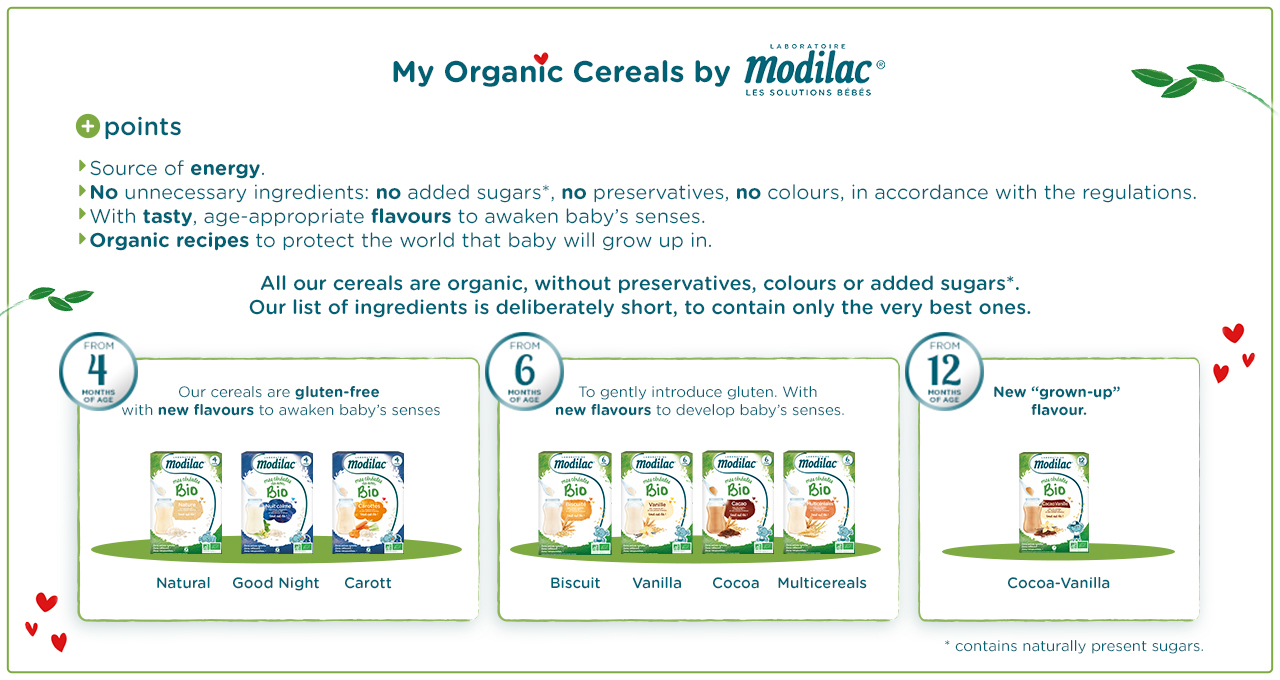Infant cereals
Overview
Why give infant cereals?
The thick and slightly lumpy texture of infant cereals is a good transition between milk and the first purées. Infant cereals replace the cereal flours that used to be added to baby’s bottle to "fill her up”.
However, they are much more suitable for baby nutrition because they comply with European and French regulations, providing important nutrients for infants and young children.
Composed mainly of carbohydrates, infant cereals give your baby energy. As part of a balanced diversified diet, carbohydrates make up 40 to 45% of a baby’s daily nutritional intake. These carbohydrates, such as starch, release the energy to stimulate your baby’s interest in the world around her.
The advantages of infant cereals
Although breast milk or infant formula is still the main food for babies between the ages of 4 and 6 months, infant cereals offer several benefits:
- Complementary feeding: gradually, new foods and nutrients are offered to baby so that he can get used to them one at a time. In particular, infant cereals containing wheat, barley, rye or oats make it possible to introduce gluten gradually and in small quantities so that the baby's body does not develop an intolerance and does not reject this protein present in many everyday foods. Infant nutrition expert groups recommend that the introduction of gluten should not be delayed. It should take place at the same time as other foods, i.e. from 4/6 months of age.
Source: ESPGHAN, JPGN 2016 and 2017
- The addition of cereals to milk allows baby to discover new flavours (sweet or savoury) and consistencies. From 6 months of age, you can also add it to purées.
- In older babies, cereals can also encourage babies reluctant to take their milk. In fact, the Société Française de Pédiatrie (French Paediatric Society) recommends continuing formula, giving 500 mL per day as part of a balanced diversified diet, up until the age of 3 years, or even longer in children who do not eat enough meat to cover their iron requirements. (Tounian & Chouraqui, Société Française de Pédiatrie, Arch Pédiatr 2017). Growing-up milk is tailored to the needs of young children, unlike cow’s milk. As part of a diversified diet, growing-up milk helps provide the nutrients your baby needs for healthy growth and development (iron, essential fatty acids, vitamin D, etc.). By adding infant cereals to growing-up milk, you can offer new tastes that will appeal to your child, who will continue to enjoy drinking his milk while at the same time getting all the nutrition he needs.
Which cereals for which age?
From 4 months of age
Infant cereals can be used as the first step in the complementary feeding process from the age of 4 months, giving 3 tablespoonfuls per day in their bottle to begin with. It is recommended that gluten be gradually introduced between the ages of 4 and 6 months.
From 6 months of age
They contain gluten and there is a wider choice to introduce baby to more flavours. More should be added to obtain a thicker texture, a sort of porridge that can be fed to baby on a spoon.
To spoon-feed your baby, wait until she can hold her head upright and sit up alone. If your baby prefers to start with her bottle, you may offer her cereals later on in the meal.
